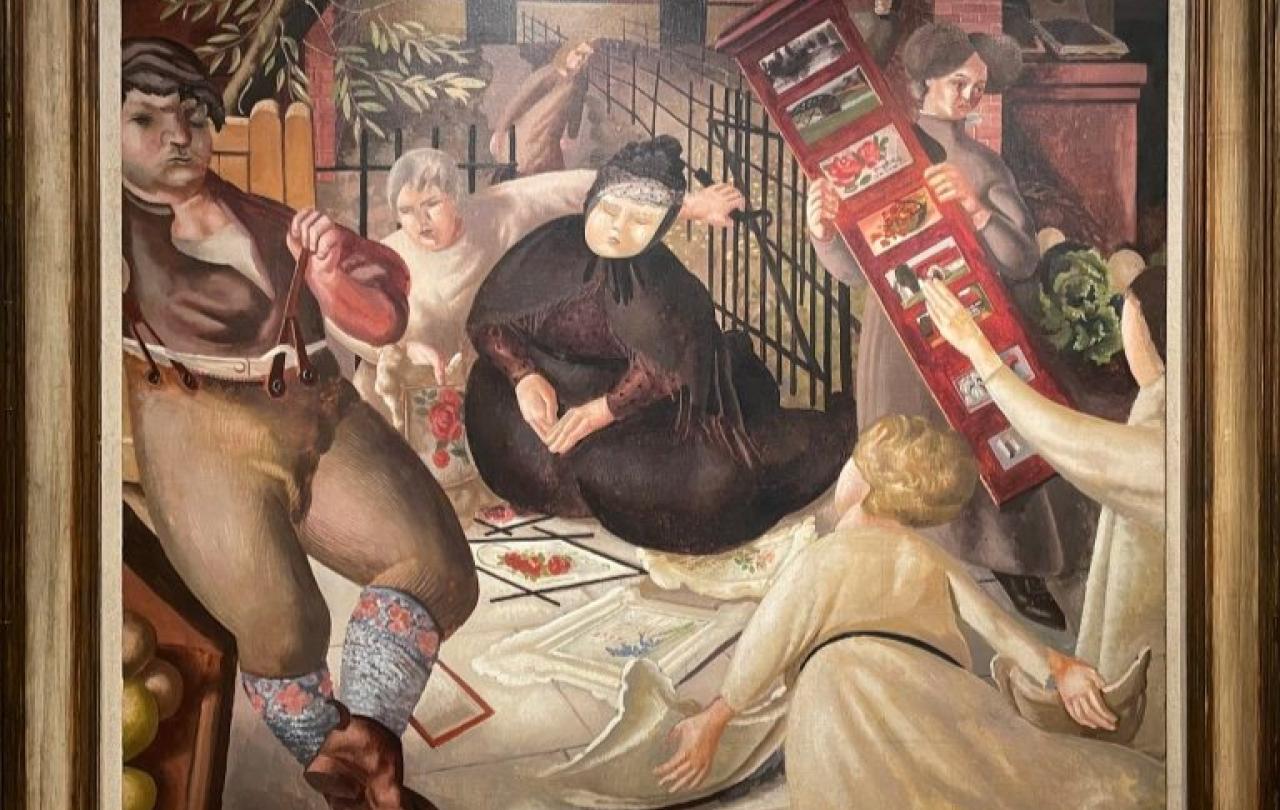
The seen and the unseen are keys to the work of Stanley Spencer but, while imagination is required to bring them together, they are not real and imaginary, rather they are real and real.
The catalogue for Seeing the Unseen: Reality and Imagination in the Art of Stanley Spencer begins with a quote from Spencer’s writings:
“Everything has a sort of double meaning for me, there’s the ordinary, everyday meaning of things, and the imaginary meaning about it all, and I wanted to bring these things together.”
Writing as he does, Spencer draws on the thinking of William Blake and Samuel Taylor Coleridge who, as Malcolm Guite has shown, viewed the imagination as not only shaping and putting things together, as Spencer describes, but also removing the dull film of familiarity that we put over everything, to see it with freshness once again. That freshness being primarily, the innocent view of a child.
This exhibition brings together stunning examples of Spencer’s realistic works – his portraits and landscapes – which he often viewed as “potboilers” that merely paid the rent, and his biblical or symbolic works which had his heart and which, in his mind, formed a vast exhibition in a “church-house”. The curators, through their apt juxtapositions, compellingly demonstrate how Spencer brought together the seen and unseen in his work.
View from Cookham Bridge (1936) is a realistic work that shows us beautifully a summer’s day in an area of great meaning to Spencer. He set his magnificent but unfinished Christ Preaching at Cookham Regatta, which is permanently on show at the Gallery and towers above everything else in the exhibition, just downstream of Cookham Bridge. Christ Preaching at Cookham Regatta teems with people and incident while, in View from Cookham Bridge, there are no people to be seen. Yet, in this painting, Spencer enables us to feel their presence – hearing the ducks and splash of oars, the chatter of people – thereby leading us to visualise the unseen.
Spencer’s biblical and symbolic images are primarily set within Cookham, as the village itself suggested settings for specific scenes to him. The Betrayal is set at the end of Spencer’s own garden where the distinctive buildings of the maltings can be seen in the background. The Last Supper is then set in those same maltings, while Sarah Tubb and the Heavenly Visitors is set in the garden of Sarah Tubb’s home on Cookham High Street. Through this means Spencer emphasises both the universality and particularity of the Bible’s stories, in that they can be reimagined or reenacted anywhere and in the humblest of settings.
Heaven in ordinary is a particular response to the incarnation – God moving into our neighbourhood – and is one that Spencer pushed to particular lengths, as is shown here through images from his Beatitudes of Love series. The Beatitudes are where Jesus turns our expectations of worldly success and achievement upside down by teaching that it is the meek and humble, the persecuted and those grieving who are blessed in God’s eyes and kingdom. In his Beatitudes of Love, Spencer demonstrates God’s acceptance of all by turning our expectations of beauty upside down and deliberately giving us characters who seem grotesque as those we are asked to admire and love.
In doing so, he is also showing his retention of a child-like vision of the world as, from the perspective of a child, all adults are large, lumpy and disproportioned. Unlike a later great religious artist, Albert Herbert, who escaped from the limitations of adult vision by deliberately painting in a child-like manner, Spencer painted with a child-like vision. This can be seen in Christ Preaching at Cookham Regatta where his child-like Christ is both rotund but wonderfully energetic as he leans forcefully forwards from his wicker chair to engage with a group of children who are responding in the range of ways that children do, from attention and captivation to distraction and disinterest.
His child-like vision and understanding are perhaps most clearly seen here in one of a series of pen and ink drawings undertaken for an almanack published by Chatto and Windus. These were domestic scenes illustrating the months of the year. The image for July is of his first wife Hilda smelling a flower. This is not an image of refined woman delicately savouring a pleasant odour, instead Hilda’s face is buried in the daisy, nose against pistil, as a child gaining the fullest experience possible.
Blake was eight years old when he first saw angels in trees on Peckham Rye. Similarly, Spencer developed his sense of Cookham as a village in heaven in childhood. He never lost that child-like vision, although at times he questioned whether it had been successfully retained. Despite many poor choices and challenging life experiences, the works shown here reveal that Spencer carried a child-like sense of wonder through his life and work and, as a result, left as his legacy the deepest and broadest vision of heaven in ordinary that any artist has been able to gift to us.
While his dream of a literal church-house in which to house his complete oeuvre was never a realisable aim, his works, taken as a whole, provide a key with which open a door allowing us to see what church and home, heaven and village, are together. Although small in size and therefore able to only show a minimal percentage of Spencer’s work at any one time, the Stanley Spencer Gallery, housed as it is in a former Wesleyan Chapel, creatively operates as a diminutive church-house for Stanley’s works, taking us deeper into his unique achievement one exhibition at a time.
SEEING THE UNSEEN: Reality and Imagination in the Art of Stanley Spencer, Stanley Spencer Gallery, Cookham, 7 November 2024 – 30 March 2025
Join with us - Behind the Seen
Seen & Unseen is free for everyone and is made possible through the generosity of our amazing community of supporters.
If you’re enjoying Seen & Unseen, would you consider making a gift towards our work?
Alongside other benefits (book discounts etc.), you’ll receive an extra fortnightly email from me sharing what I’m reading and my reflections on the ideas that are shaping our times.
Graham Tomlin
Editor-in-Chief





